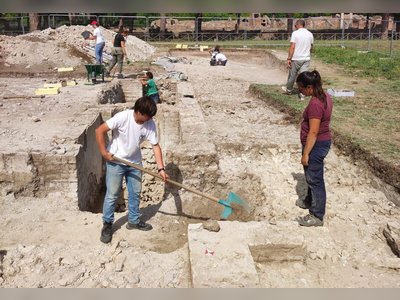Culling of Infected Cattle in Hegyeshalom Amid Foot-and-Mouth Disease Outbreak
Local farmers express concerns as hundreds of cattle are disposed of in newly dug mass graves near Austria.
In Hegyeshalom, Hungary, significant operations are underway to cull and dispose of cattle infected with foot-and-mouth disease (FMD).
The culling started on Sunday and is set to involve hundreds of cows from a local farm in Levele, which was officially ordered to be depopulated due to the outbreak.
Reports indicate that approximately 200 cattle were brought to the site for disposal on the first day of operations, with efforts intensifying on the following day.
A local resident, a retiree with decades of experience in cattle farming, expressed concern about the uncertainty surrounding the water supply.
With a personal well, he questions the safety of using water for cooking and hygiene given the recent reports of infected animals buried just a kilometer and a half away.
The Hungarian Agricultural Minister, István Nagy, visited the area, assuring locals that plans are in place to develop a drinking water supply system.
The infected cattle are transported from Levele to a designated burial site near Csemeztanya where they are interred in deep graves excavated by heavy machinery.
Authorities are taking precautions at the site, with police present to ensure that unauthorized individuals do not gain access.
The burials are taking place in close proximity to the Austrian border; however, testing of livestock in the Burgenland region, which is only a few kilometers away, has returned negative results.
As part of emergency measures, a monitoring program is being implemented in eastern Lower Austria and North and Central Burgenland.
This aims to oversee local farms and prevent further spread of the virus.
Residents of Hegyeshalom are reportedly anxious, with an extraordinary municipal meeting convened to address the outbreak.
Plans for the site include the establishment of water quality monitoring wells and the enclosure of the affected area.
While the immediate focus remains on the eradication of the disease, local farmers express feelings of despair.
One farmer mentioned that he had planned to sell a bull earlier in the year but now faces uncertainty regarding the future of his herd.
Similar concerns are echoed among various cattle owners, many of whom rely on livestock farming for their livelihood.
Foot-and-mouth disease is a highly contagious viral infection affecting cloven-hoofed animals, including cattle, pigs, goats, and sheep.
Symptoms include fever, loss of appetite, excessive salivation, and blister-like lesions in the mouth and on extremities.
Although transmission to humans is exceedingly rare, the economic implications for livestock farmers can be severe.
The current outbreak of foot-and-mouth disease in Hungary marks the first occurrence of the virus in the country in fifty years, with the initial cases traced back to a farm in the vicinity of Kisbajcs.
Despite implementing border controls, the disease spread to additional farms, culminating in the confirmation of the virus at the Levele facility by March 25.
In the past, outbreaks have led to strict slaughtering measures to eliminate infected stock completely, as vaccines provide limited protection against the transmission of the virus and do not prevent infection.
The ongoing containment strategy primarily focuses on eradicating the virus at its source, which entails culling affected herds.
The culling started on Sunday and is set to involve hundreds of cows from a local farm in Levele, which was officially ordered to be depopulated due to the outbreak.
Reports indicate that approximately 200 cattle were brought to the site for disposal on the first day of operations, with efforts intensifying on the following day.
A local resident, a retiree with decades of experience in cattle farming, expressed concern about the uncertainty surrounding the water supply.
With a personal well, he questions the safety of using water for cooking and hygiene given the recent reports of infected animals buried just a kilometer and a half away.
The Hungarian Agricultural Minister, István Nagy, visited the area, assuring locals that plans are in place to develop a drinking water supply system.
The infected cattle are transported from Levele to a designated burial site near Csemeztanya where they are interred in deep graves excavated by heavy machinery.
Authorities are taking precautions at the site, with police present to ensure that unauthorized individuals do not gain access.
The burials are taking place in close proximity to the Austrian border; however, testing of livestock in the Burgenland region, which is only a few kilometers away, has returned negative results.
As part of emergency measures, a monitoring program is being implemented in eastern Lower Austria and North and Central Burgenland.
This aims to oversee local farms and prevent further spread of the virus.
Residents of Hegyeshalom are reportedly anxious, with an extraordinary municipal meeting convened to address the outbreak.
Plans for the site include the establishment of water quality monitoring wells and the enclosure of the affected area.
While the immediate focus remains on the eradication of the disease, local farmers express feelings of despair.
One farmer mentioned that he had planned to sell a bull earlier in the year but now faces uncertainty regarding the future of his herd.
Similar concerns are echoed among various cattle owners, many of whom rely on livestock farming for their livelihood.
Foot-and-mouth disease is a highly contagious viral infection affecting cloven-hoofed animals, including cattle, pigs, goats, and sheep.
Symptoms include fever, loss of appetite, excessive salivation, and blister-like lesions in the mouth and on extremities.
Although transmission to humans is exceedingly rare, the economic implications for livestock farmers can be severe.
The current outbreak of foot-and-mouth disease in Hungary marks the first occurrence of the virus in the country in fifty years, with the initial cases traced back to a farm in the vicinity of Kisbajcs.
Despite implementing border controls, the disease spread to additional farms, culminating in the confirmation of the virus at the Levele facility by March 25.
In the past, outbreaks have led to strict slaughtering measures to eliminate infected stock completely, as vaccines provide limited protection against the transmission of the virus and do not prevent infection.
The ongoing containment strategy primarily focuses on eradicating the virus at its source, which entails culling affected herds.
AI Disclaimer: An advanced artificial intelligence (AI) system generated the content of this page on its own. This innovative technology conducts extensive research from a variety of reliable sources, performs rigorous fact-checking and verification, cleans up and balances biased or manipulated content, and presents a minimal factual summary that is just enough yet essential for you to function as an informed and educated citizen. Please keep in mind, however, that this system is an evolving technology, and as a result, the article may contain accidental inaccuracies or errors. We urge you to help us improve our site by reporting any inaccuracies you find using the "Contact Us" link at the bottom of this page. Your helpful feedback helps us improve our system and deliver more precise content. When you find an article of interest here, please look for the full and extensive coverage of this topic in traditional news sources, as they are written by professional journalists that we try to support, not replace. We appreciate your understanding and assistance.











